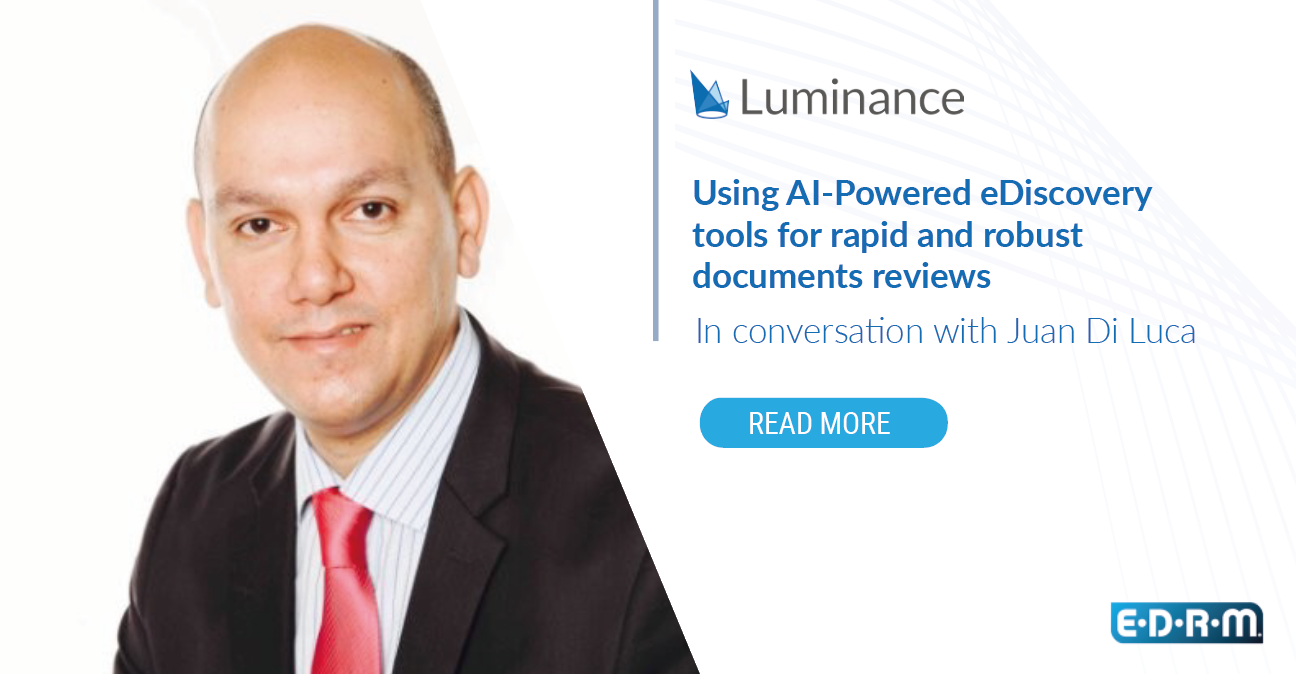
Blog
Using AI-Powered eDiscovery tools for rapid and robust document review
10 September 2020 | Luminance
Luminance recently co-hosted a virtual discussion with the Electronic Discovery Reference Model (EDRM). EDRM has worked to improve e-discovery, privacy, security, and information governance since 2005, delivering innovative training and tools to strengthen best practices for law firms, corporations and government organizations globally. During the webinar, Jason Brennan, acting CEO of Luminance, spoke with Juan Di Luca, Founder and Operations Director at Data Analysis Services Ltd about his experiences in using advanced legal technology and why he thinks AI will shake up the e-Discovery market.
Data Analysis Services Ltd works with organisations to improve their eDiscovery workflow by implementing latest generation technology. Their founder, Juan Di Luca, says that they serve clients at all different levels around the globe, helping them to integrate innovative legal strategies. Juan notes that one key issue has been that legal technologies have not been very user-friendly up until this point. He notes that Luminance runs counter to this general trend, as it “is addressing that very point through its data visualisation and intuitive interface.” Luminance’s unique blend of both supervised and unsupervised machine learning is able to rapidly read and form an understanding of legal datasets, instantly surfacing crucial information such as clauses, standards, deviations and anomalies, without the need for pre-programming or configuration. It then breaks down its findings across a number of interactive graphic widgets which lawyers can use as a way of beginning or structuring their investigation. Using Luminance, legal teams can generate time-savings of at least 50% on day one of the review.
Luminance does not require any pre-programming or training, allowing lawyers to instantly form an understanding of the dataset. In addition, Luminance is a language and jurisdiction-agnostic technology, currently working in over 80 languages, and as such is able to immediately ingest and analyse documents irrespective of language, jurisdiction or form. Juan comments that certain technologies require a certification or technology experts to implement them. He believes that “this could create a barrier for those with no experience” and it has resulted in what Juan calls a “segregation of the practice of law and technology” where lawyers find it difficult to fully grasp their role in deploying technology. Juan continues, “it is very important for lawyers to understand the value of these technologies but also to be able to handle it. If technology is presented in a way that is easy to use, the lawyer can have full control.”
Jason Brennon, acting CEO of Luminance, notes, “if something seems really complicated to set-up or use, you separate yourself from it and that diminishes its value.” Innovative solutions such as Luminance allow the user to deploy technology to the level of complexity that they require, with tailored onboarding programs and varying tools depending on each individual’s role in a team.
During the current crisis, Juan notes that working from home has “opened up the conversation for the remote use of technology” and paved the way for greater acceptance by lawyers of their individual adoption of these tools. Juan says that this is definitely “a step in the right direction.” Even so, he believes that success for lawyers lies in adopting technology early and in advance, “not only as a reactive measure but more as a proactive approach.”